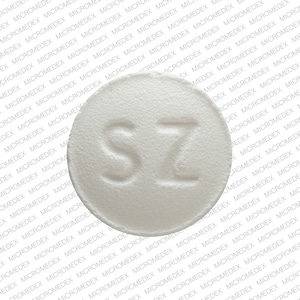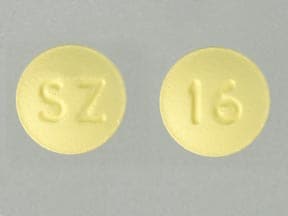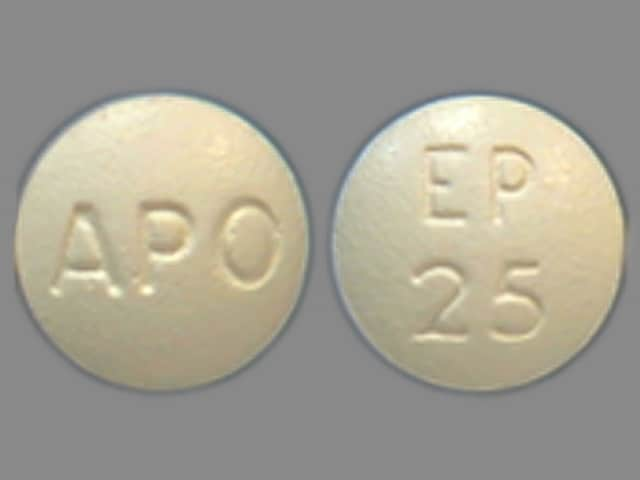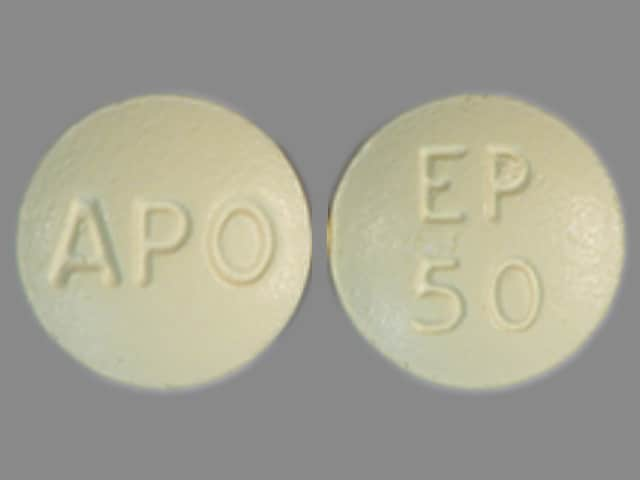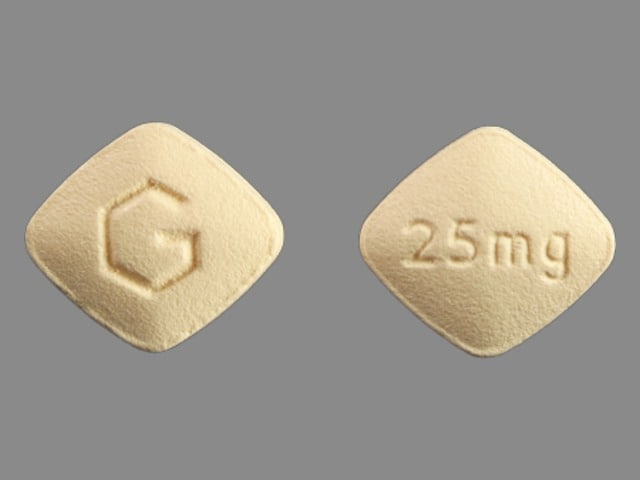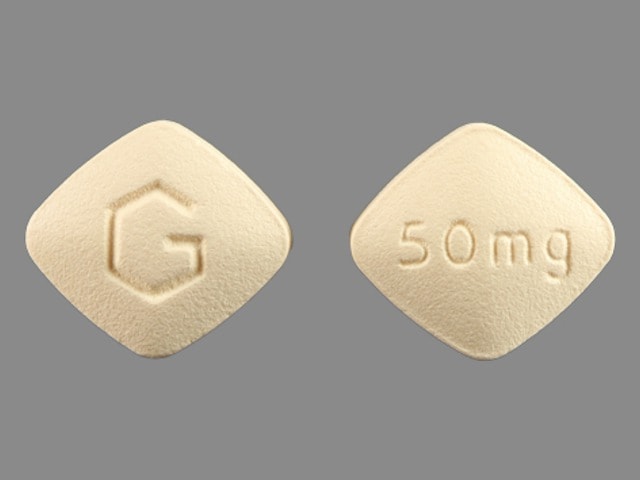Dosage Forms
Excipient information presented when available (limited, particularly for generics); consult specific product labeling.
Tablet, Oral:
Inspra: 25 mg, 50 mg
Generic: 25 mg, 50 mg
Pharmacology
Mechanism of Action
Aldosterone, a mineralocorticoid, increases blood pressure primarily by inducing sodium and water retention. Overexpression of aldosterone is thought to contribute to myocardial fibrosis (especially following myocardial infarction) and vascular fibrosis. Mineralocorticoid receptors are located in the kidney, heart, blood vessels, and brain. Eplerenone selectively blocks mineralocorticoid receptors reducing blood pressure in a dose-dependent manner and appears to prevent myocardial and vascular fibrosis.
Pharmacokinetics/Pharmacodynamics
Distribution
Vd: 42 to 90 L
Metabolism
Primarily hepatic via CYP3A4; metabolites inactive
Excretion
Urine (~67%); feces (~32%); <5% as unchanged drug in urine and feces
Time to Peak
Plasma: ~1.5 to 2 hours; may take up to 4 weeks for full antihypertensive effect
Half-Life Elimination
~3 to 6 hours
Protein Binding
~50%; primarily to alpha1-acid glycoproteins
Use in Specific Populations
Special Populations: Renal Function Impairment
AUC and Cmax increased 38% and 24%, respectively, in severe renal impairment and decreased by 26% and 3%, respectively, in hemodialysis.
Special Populations: Hepatic Function Impairment
Cmax and AUC increased 3.6% and 42%, respectively, in moderate hepatic impairment.
Special Populations: Elderly
Cmax and AUC increased 22% and 45%, respectively.
Special Populations: Race
Cmax and AUC decreased 19% and 25%, respectively, in black patients.
Use: Labeled Indications
Hypertension: Management of hypertension. Note: Not recommended for the initial treatment of hypertension (ACC/AHA [Whelton 2018]).
Post myocardial infarction, complicated by heart failure with reduced ejection fraction: To improve survival of stable patients with symptomatic heart failure (left ventricular ejection fraction ≤40%) following acute myocardial infarction.
Use: Off Label
Heart failure with preserved ejection fractionyes
Based on the American College of Cardiology (ACC)/American Heart Association (AHA)/Heart Failure Society of America update of the guideline for the management of heart failure, eplerenone may be effective and might be considered to reduce hospitalizations for heart failure in appropriately selected patients with symptomatic heart failure with preserved ejection fraction (ejection fraction ≥45%) who have an elevated serum natriuretic peptide level or have been hospitalized for heart failure in the last 12 months ACC/AHA/HFSA [Yancy 2017].
Heart failure with reduced ejection fractionayes
Data from a randomized, double-blind, placebo-controlled trial of patients with heart failure with reduced ejection fraction plus New York Heart Association (NYHA) class II symptoms suggest that eplerenone is effective at reducing cardiovascular death and hospitalization in this population Zannad 2011.
Based on the American College of Cardiology Foundation/AHA guidelines for the management of heart failure, eplerenone (along with other guideline directed medical therapies) is effective and recommended to reduce morbidity and mortality in patients with heart failure (NYHA class II to IV) with a left ventricular ejection fraction ≤35% ACCF/AHA [Yancy 2013].
Primary aldosteronismyes
Based on the Endocrine Society guidelines for the management of primary aldosteronism, eplerenone is an effective and recommended alternative agent for the treatment of bilateral adrenal hypersecretion; also an alternative agent for the treatment of unilateral hypersecretion in patients unwilling or unable to undergo surgery ES [Funder 2016].
Contraindications
Serum potassium >5.5 mEq/L at initiation; CrCl ≤30 mL/minute; concomitant use of strong CYP3A4 inhibitors (eg, ketoconazole, itraconazole, nefazodone, troleandomycin, clarithromycin, ritonavir, nelfinavir).
The following additional contraindications apply to patients with hypertension: Type 2 diabetes mellitus (noninsulin dependent, NIDDM) with microalbuminuria; serum creatinine >2.0 mg/dL in males or >1.8 mg/dL in females; CrCl <50 mL/minute; concomitant use with potassium supplements or potassium-sparing diuretics (eg, amiloride, spironolactone, triamterene).
Per the Endocrine Society clinical practice guidelines, use in patients with Addison disease is contraindicated (Endocrine Society [Bornstein 2016])
Canadian labeling: Additional contraindications (not in US labeling): Hypersensitivity to eplerenone or any component of the formulation; serum potassium >5 mEq/L at initiation; severe hepatic impairment (Child-Pugh class C); clinically significant hyperkalemia; concomitant use with potassium supplements or potassium-sparing diuretics
The following additional contraindications apply to patients with hypertension: Serum creatinine >1.5 mg/dL [132 micromole/L] in males or >1.3 mg/dL [115 micromole/L] in females
Dosage and Administration
Dosing: Adult
Heart failure:
Note: When initiating therapy for any of the heart failure indications below, verify the following: serum potassium <5 mEq/L and either serum creatinine ≤2.5 mg/dL in men and ≤2 mg/dL in women or eGFR >30 mL/minute/1.73 m2. If patient develops hyperkalemia (serum potassium >5.5 mEq/L), reduce the dose, change to every-other-day dosing, or discontinue therapy. If renal function worsens, consider dose reduction or discontinuation (ACC/AHA/HFSA [Yancy 2017]; ACCF/AHA [Yancy 2013]).
Heart failure with preserved ejection fraction (off-label use):
Note: May be considered for use in patients with symptomatic heart failure with preserved ejection fraction (≥45%) who have an elevated serum natriuretic peptide level or have been hospitalized for heart failure in the last 12 months (ACC/AHA/HFSA [Yancy 2017]). Some experts recommend initiating therapy only if serum potassium is ≤4.7 mEq/L and eGFR is ≥30 mL/minute/1.73 m2. The same experts recommend dose reduction when serum potassium is >5 mEq/L and discontinuation when serum potassium is >5.5 mEq/L (Borlaug 2020).
Oral: Initial: 25 mg once daily; may double the dose after 4 weeks if serum potassium remains <5 mEq/L and renal function is stable, to a maximum target dose of 50 mg once daily (ACC/AHA/HFSA [Yancy 2017]; Borlaug 2020). Some experts recommend up-titrating therapy only if serum potassium is ≤4.5 mEq/L (Borlaug 2020).
Heart failure with reduced ejection fraction (off-label use):
Note: Should be considered for use in patients with symptomatic (New York Heart Association class II to IV) heart failure with reduced ejection fraction (≤35%) who are already taking optimal doses of other heart failure therapies (ACC/AHA/HFSA [Yancy 2017]; ACCF/AHA [Yancy 2013]).
Oral: Initial: 25 mg once daily; may double the dose after 4 weeks if serum potassium remains <5 mEq/L and renal function is stable, to a maximum target dose of 50 mg once daily (ACC/AHA/HFSA [Yancy 2017]; ACCF/AHA [Yancy 2013]; Zannad 2011).
Post myocardial infarction, complicated by reduced ejection fraction:
Note: Should be considered for use following acute myocardial infarction in patients with left ventricular ejection fraction ≤40% plus symptoms of heart failure or diabetes. Use in addition to other pharmacologic therapies (ACCF/AHA [O’Gara 2013]; ACCF/AHA [Yancy 2013]).
Oral: Initial: 25 mg once daily; may double the dose after 4 weeks if serum potassium remains <5 mEq/L and renal function is stable, up to a maximum target dose of 50 mg once daily (ACCF/AHA [Yancy 2013]).
Hypertension (alternative agent):
Note: Not recommended for initial management but may be considered as additional therapy for resistant hypertension in patients who do not respond adequately to combination therapy with preferred agents (ACC/AHA [Whelton 2018]; Bazoukis 2018).
Oral: Initial: 50 mg once daily; after 4 weeks increase dose as needed based on response and tolerability up to a maximum of 50 mg twice daily (ACC/AHA [Whelton 2018]; Bazoukis 2018).
Primary aldosteronism (alternative agent) (off-label use):
Note: Alternative to spironolactone (ES [Funder 2016]).
Oral: Initial: 25 mg twice daily; gradually titrate to the lowest effective dose; usual maximum dose: 300 mg/day. For surgical candidates, the last dose should be administered the day of surgery; discontinue eplerenone on postoperative day one (ES [Funder 2016]; Parthasarathy 2011).
Dosing: Geriatric
Refer to adult dosing.
Administration
Oral: Administer with or without food.
Dietary Considerations
Do not use salt substitutes containing potassium.
Storage
Store at 25°C (77°F); excursions permitted to 15°C to 30°C (59°F to 86°F).
Eplerenone Images
Drug Interactions
Alfuzosin: May enhance the hypotensive effect of Blood Pressure Lowering Agents. Monitor therapy
Amifostine: Blood Pressure Lowering Agents may enhance the hypotensive effect of Amifostine. Management: When amifostine is used at chemotherapy doses, blood pressure lowering medications should be withheld for 24 hours prior to amifostine administration. If blood pressure lowering therapy cannot be withheld, amifostine should not be administered. Consider therapy modification
Ammonium Chloride: Potassium-Sparing Diuretics may enhance the adverse/toxic effect of Ammonium Chloride. Specifically the risk of systemic acidosis. Consider therapy modification
Amphetamines: May diminish the antihypertensive effect of Antihypertensive Agents. Monitor therapy
Angiotensin II Receptor Blockers: Eplerenone may enhance the hyperkalemic effect of Angiotensin II Receptor Blockers. Monitor therapy
Angiotensin-Converting Enzyme Inhibitors: Eplerenone may enhance the hyperkalemic effect of Angiotensin-Converting Enzyme Inhibitors. Monitor therapy
Antipsychotic Agents (Second Generation [Atypical]): Blood Pressure Lowering Agents may enhance the hypotensive effect of Antipsychotic Agents (Second Generation [Atypical]). Monitor therapy
Barbiturates: May enhance the hypotensive effect of Blood Pressure Lowering Agents. Monitor therapy
Benperidol: May enhance the hypotensive effect of Blood Pressure Lowering Agents. Monitor therapy
Bosentan: May decrease the serum concentration of CYP3A4 Substrates (High risk with Inducers). Monitor therapy
Brigatinib: May diminish the antihypertensive effect of Antihypertensive Agents. Brigatinib may enhance the bradycardic effect of Antihypertensive Agents. Monitor therapy
Brimonidine (Topical): May enhance the hypotensive effect of Blood Pressure Lowering Agents. Monitor therapy
Bromperidol: Blood Pressure Lowering Agents may enhance the hypotensive effect of Bromperidol. Bromperidol may diminish the hypotensive effect of Blood Pressure Lowering Agents. Avoid combination
Cardiac Glycosides: Potassium-Sparing Diuretics may diminish the therapeutic effect of Cardiac Glycosides. In particular, the inotropic effects of digoxin appear to be diminished. Potassium-Sparing Diuretics may increase the serum concentration of Cardiac Glycosides. This particular effect may be unique to Spironolactone. Monitor therapy
Clofazimine: May increase the serum concentration of CYP3A4 Substrates (High risk with Inhibitors). Monitor therapy
Conivaptan: May increase the serum concentration of CYP3A4 Substrates (High risk with Inhibitors). Avoid combination
CycloSPORINE (Systemic): Eplerenone may enhance the hyperkalemic effect of CycloSPORINE (Systemic). Avoid combination
CYP3A4 Inducers (Moderate): May decrease the serum concentration of CYP3A4 Substrates (High risk with Inducers). Monitor therapy
CYP3A4 Inducers (Strong): May increase the metabolism of CYP3A4 Substrates (High risk with Inducers). Management: Consider an alternative for one of the interacting drugs. Some combinations may be specifically contraindicated. Consult appropriate manufacturer labeling. Consider therapy modification
CYP3A4 Inhibitors (Moderate): May increase the serum concentration of Eplerenone. Management: When used concomitantly with moderate inhibitors of CYP3A4, eplerenone dosing recommendations vary by indication and international labeling. See full drug interaction monograph for details. Consider therapy modification
CYP3A4 Inhibitors (Strong): May increase the serum concentration of Eplerenone. Avoid combination
Dabrafenib: May decrease the serum concentration of CYP3A4 Substrates (High risk with Inducers). Management: Seek alternatives to the CYP3A4 substrate when possible. If concomitant therapy cannot be avoided, monitor clinical effects of the substrate closely (particularly therapeutic effects). Consider therapy modification
Deferasirox: May decrease the serum concentration of CYP3A4 Substrates (High risk with Inducers). Monitor therapy
Dexmethylphenidate: May diminish the therapeutic effect of Antihypertensive Agents. Monitor therapy
Diacerein: May enhance the therapeutic effect of Diuretics. Specifically, the risk for dehydration or hypokalemia may be increased. Monitor therapy
Diazoxide: May enhance the hypotensive effect of Blood Pressure Lowering Agents. Monitor therapy
Drospirenone: May enhance the hyperkalemic effect of Potassium-Sparing Diuretics. Monitor therapy
DULoxetine: Blood Pressure Lowering Agents may enhance the hypotensive effect of DULoxetine. Monitor therapy
Enzalutamide: May decrease the serum concentration of CYP3A4 Substrates (High risk with Inducers). Management: Concurrent use of enzalutamide with CYP3A4 substrates that have a narrow therapeutic index should be avoided. Use of enzalutamide and any other CYP3A4 substrate should be performed with caution and close monitoring. Consider therapy modification
Erdafitinib: May decrease the serum concentration of CYP3A4 Substrates (High risk with Inducers). Monitor therapy
Erdafitinib: May increase the serum concentration of CYP3A4 Substrates (High risk with Inhibitors). Monitor therapy
Fluconazole: May increase the serum concentration of Eplerenone. Management: Reduce the starting dose of eplerenone to 25 mg/day; monitor patients closely for increased eplerenone effects. Consider therapy modification
Fosaprepitant: May increase the serum concentration of CYP3A4 Substrates (High risk with Inhibitors). Monitor therapy
Fusidic Acid (Systemic): May increase the serum concentration of CYP3A4 Substrates (High risk with Inhibitors). Avoid combination
Heparin: May enhance the hyperkalemic effect of Eplerenone. Monitor therapy
Heparins (Low Molecular Weight): May enhance the hyperkalemic effect of Eplerenone. Monitor therapy
Herbs (Hypertensive Properties): May diminish the antihypertensive effect of Antihypertensive Agents. Monitor therapy
Herbs (Hypotensive Properties): May enhance the hypotensive effect of Blood Pressure Lowering Agents. Monitor therapy
Hypotension-Associated Agents: Blood Pressure Lowering Agents may enhance the hypotensive effect of Hypotension-Associated Agents. Monitor therapy
Idelalisib: May increase the serum concentration of CYP3A4 Substrates (High risk with Inhibitors). Avoid combination
Itraconazole: May increase the serum concentration of Eplerenone. Avoid combination
Ivosidenib: May decrease the serum concentration of CYP3A4 Substrates (High risk with Inducers). Monitor therapy
Ketoconazole (Systemic): May increase the serum concentration of Eplerenone. Avoid combination
Larotrectinib: May increase the serum concentration of CYP3A4 Substrates (High risk with Inhibitors). Monitor therapy
Levodopa-Containing Products: Blood Pressure Lowering Agents may enhance the hypotensive effect of Levodopa-Containing Products. Monitor therapy
Lithium: Eplerenone may increase the serum concentration of Lithium. Monitor therapy
Lorlatinib: May decrease the serum concentration of CYP3A4 Substrates (High risk with Inducers). Management: Avoid concurrent use of lorlatinib with any CYP3A4 substrates for which a minimal decrease in serum concentrations of the CYP3A4 substrate could lead to therapeutic failure and serious clinical consequences. Consider therapy modification
Lormetazepam: May enhance the hypotensive effect of Blood Pressure Lowering Agents. Monitor therapy
Methylphenidate: May diminish the antihypertensive effect of Antihypertensive Agents. Monitor therapy
Mitotane: May decrease the serum concentration of CYP3A4 Substrates (High risk with Inducers). Management: Doses of CYP3A4 substrates may need to be adjusted substantially when used in patients being treated with mitotane. Consider therapy modification
Molsidomine: May enhance the hypotensive effect of Blood Pressure Lowering Agents. Monitor therapy
Naftopidil: May enhance the hypotensive effect of Blood Pressure Lowering Agents. Monitor therapy
Nicergoline: May enhance the hypotensive effect of Blood Pressure Lowering Agents. Monitor therapy
Nicorandil: May enhance the hyperkalemic effect of Potassium-Sparing Diuretics. Monitor therapy
Nicorandil: May enhance the hypotensive effect of Blood Pressure Lowering Agents. Monitor therapy
Nitrofurantoin: May enhance the hyperkalemic effect of Eplerenone. Monitor therapy
Nitroprusside: Blood Pressure Lowering Agents may enhance the hypotensive effect of Nitroprusside. Monitor therapy
Nonsteroidal Anti-Inflammatory Agents: May diminish the antihypertensive effect of Eplerenone. Nonsteroidal Anti-Inflammatory Agents may enhance the hyperkalemic effect of Eplerenone. Monitor therapy
Obinutuzumab: May enhance the hypotensive effect of Blood Pressure Lowering Agents. Management: Consider temporarily withholding blood pressure lowering medications beginning 12 hours prior to obinutuzumab infusion and continuing until 1 hour after the end of the infusion. Consider therapy modification
Opioid Agonists: May enhance the adverse/toxic effect of Diuretics. Opioid Agonists may diminish the therapeutic effect of Diuretics. Monitor therapy
Palbociclib: May increase the serum concentration of CYP3A4 Substrates (High risk with Inhibitors). Monitor therapy
Pentoxifylline: May enhance the hypotensive effect of Blood Pressure Lowering Agents. Monitor therapy
Pholcodine: Blood Pressure Lowering Agents may enhance the hypotensive effect of Pholcodine. Monitor therapy
Phosphodiesterase 5 Inhibitors: May enhance the hypotensive effect of Blood Pressure Lowering Agents. Monitor therapy
Posaconazole: May increase the serum concentration of Eplerenone. Avoid combination
Potassium Salts: Eplerenone may enhance the hyperkalemic effect of Potassium Salts. Management: This combination is contraindicated in patients receiving eplerenone for treatment of hypertension. Consider therapy modification
Potassium-Sparing Diuretics: Eplerenone may enhance the hyperkalemic effect of Potassium-Sparing Diuretics. Management: This combination is contraindicated in patients receiving eplerenone for treatment of hypertension. Consider therapy modification
Prostacyclin Analogues: May enhance the hypotensive effect of Blood Pressure Lowering Agents. Monitor therapy
Quinagolide: May enhance the hypotensive effect of Blood Pressure Lowering Agents. Monitor therapy
QuiNIDine: Potassium-Sparing Diuretics may diminish the therapeutic effect of QuiNIDine. Monitor therapy
Sarilumab: May decrease the serum concentration of CYP3A4 Substrates (High risk with Inducers). Monitor therapy
Siltuximab: May decrease the serum concentration of CYP3A4 Substrates (High risk with Inducers). Monitor therapy
Simeprevir: May increase the serum concentration of CYP3A4 Substrates (High risk with Inhibitors). Monitor therapy
Sodium Phosphates: Diuretics may enhance the nephrotoxic effect of Sodium Phosphates. Specifically, the risk of acute phosphate nephropathy may be enhanced. Management: Consider avoiding this combination by temporarily suspending treatment with diuretics, or seeking alternatives to oral sodium phosphate bowel preparation. If the combination cannot be avoided, hydrate adequately and monitor fluid and renal status. Consider therapy modification
Stiripentol: May increase the serum concentration of CYP3A4 Substrates (High risk with Inhibitors). Management: Use of stiripentol with CYP3A4 substrates that are considered to have a narrow therapeutic index should be avoided due to the increased risk for adverse effects and toxicity. Any CYP3A4 substrate used with stiripentol requires closer monitoring. Consider therapy modification
Tacrolimus (Systemic): Eplerenone may enhance the hyperkalemic effect of Tacrolimus (Systemic). Avoid combination
Tocilizumab: May decrease the serum concentration of CYP3A4 Substrates (High risk with Inducers). Monitor therapy
Tolvaptan: May enhance the hyperkalemic effect of Potassium-Sparing Diuretics. Monitor therapy
Trimethoprim: May enhance the hyperkalemic effect of Eplerenone. Monitor therapy
Voriconazole: May increase the serum concentration of Eplerenone. Avoid combination
Yohimbine: May diminish the antihypertensive effect of Antihypertensive Agents. Monitor therapy
Test Interactions
May lead to false negative aldosterone/renin ratio (ES [Funder 2016]; Mulatero 2002).
Adverse Reactions
>10%: Endocrine & metabolic: Hyperkalemia ([cardiac failure, post-myocardial infarction: >5.5 mEq/L: 16%; ≥6 mEq/L: 6%], [hypertension, >5.5 mEq/L: at dose of 400 mg: 9%; dose ≤200 mg: ≤1%]), hypertriglyceridemia (1% to 15%; dose-related)
1% to 10%:
Central nervous system: Dizziness (3%), fatigue (2%)
Endocrine & metabolic: Hyponatremia (2%; dose-related), albuminuria (1%), gynecomastia (≤1%), hypercholesterolemia (≤1%)
Gastrointestinal: Diarrhea (2%), abdominal pain (1%)
Genitourinary: Abnormal vaginal hemorrhage (≤2%), mastalgia (males: ≤1%)
Renal: Increased serum creatinine (cardiac failure, post-myocardial infarction: 6%)
Respiratory: Cough (2%), flu-like symptoms (2%)
<1%, postmarketing, and/or case reports: Angioedema, increased blood urea nitrogen, increased liver enzymes, increased uric acid, skin rash
Warnings/Precautions
Concerns related to adverse effects:
- Hyperkalemia: Hyperkalemia may occur; risk of hyperkalemia is increased with renal impairment, proteinuria, diabetes, and patients taking concomitant angiotensin-converting enzyme (ACE) inhibitors, angiotensin-II receptor blockers (ARBs), nonsteroidal anti-inflammatory drugs (NSAIDs), and/or moderate CYP3A inhibitors. Monitor closely for hyperkalemia; increases in serum potassium were dose related during clinical trials (ACCF/AHA [Yancy 2013]). Dose reduction or interruption of therapy may be necessary with development of hyperkalemia. If concomitant moderate CYP3A4 inhibitor therapy cannot be avoided, reduce dose of eplerenone. Use is contraindicated in patients with potassium >5.5 mEq/L at initiation of therapy.
Disease-related concerns:
- Diabetes: Use with caution in patients with heart failure post-myocardial infarction with diabetes (especially if patient has proteinuria); risk of hyperkalemia is increased.
- Heart failure: When evaluating a heart failure patient for eplerenone treatment, eGFR should be >30 mL/minute/1.73 m2 or creatinine should be ≤2.5 mg/dL (men) or ≤2 mg/dL (women) with no recent worsening and potassium <5 mEq/L with no history of severe hyperkalemia. Serum potassium levels require close monitoring and management if elevated. The American College of Cardiology Foundation/American Heart Association recommends considering discontinuation upon the development of serum potassium >5.5 mEq/L or worsening renal function with careful evaluation of the entire medical regimen. Avoid triple therapy with the combined use of an ACE inhibitor, ARB, and eplerenone. Therapy may need to be modified during an episode of diarrhea or dehydration or when loop diuretic therapy is interrupted (ACCF/AHA [Yancy 2013]).
- Hepatic impairment: Use with caution in patients with moderate to severe hepatic impairment.
- Renal impairment: Risk of hyperkalemia is increased with declining renal function. Use with caution in patients with mild renal impairment; based on indication and degree of impairment use may be contraindicated (refer to contraindications field).
Concurrent drug therapy issues:
- Drug-drug interactions: Potentially significant interactions may exist, requiring dose or frequency adjustment, additional monitoring, and/or selection of alternative therapy. Consult drug interactions database for more detailed information.
- Potassium supplements: Avoid potassium supplements, potassium-containing salt substitutes, a diet rich in potassium, or other drugs that can cause hyperkalemia (eg, other potassium-sparing diuretics, NSAIDs). Concomitant use of potassium supplements or potassium-sparing diuretics is contraindicated in the treatment of hypertension.
Monitoring Parameters
BP; serum potassium (prior to therapy, within the first week, 1 month after start of treatment or dose adjustment, then periodically as clinically indicated); serum potassium and serum creatinine within 3 to 7 days after initiating concurrent therapy with a moderate CYP3A inhibitor, angiotensin-converting enzyme (ACE) inhibitor, angiotensin-II receptor blocker (ARB), or nonsteroidal anti-inflammatory drug.
Heart failure: Serum potassium and renal function should be checked in 3 days after initiation, at 1 week after initiation, at least monthly for the first 3 months of therapy, and every 3 months thereafter. If adding or increasing the dose of concomitant ACE inhibitors or ARBs, a new cycle of monitoring should be done. If serum potassium increases to >5.5 mEq/L or renal function worsens, hold doses until potassium is <5 mEq/L and consider restarting with a reduced dose after confirming resolution of hyperkalemia/renal insufficiency for at least 72 hours (ACC/AHA [Yancy 2013]).
Pregnancy
Pregnancy Considerations
Information related to eplerenone use in pregnancy is limited to case reports (Cabassi 2012; Gunganah 2015; Hutter 2006; Morton 2011; Morton 2017).
Chronic maternal hypertension is associated with adverse events in the fetus/infant. The risk of birth defects, low birth weight, premature delivery, stillbirth, and neonatal death may be increased with chronic hypertension in pregnancy. Actual risks may be related to duration and severity of maternal hypertension. The use of mineralocorticoid receptor antagonists for the treatment of hypertension in pregnancy is generally not recommended (ACOG 203 2019).
The treatment of edema associated with chronic heart failure during pregnancy is similar to that of nonpregnant patients. However, the use of mineralocorticoid receptor antagonists is not recommended. Patients diagnosed after delivery can be treated according to heart failure guidelines (ESC [Bauersachs 2016]; ESC [Regitz-Zagrosek 2018]).
Information related to the use of mineralocorticoid receptor antagonists for the treatment of primary hyperaldosteronism in pregnancy is limited. Use of eplerenone may be considered in some cases (Riester 2015).
Patient Education
What is this drug used for?
- It is used to treat high blood pressure.
- It is used to help heart function after a heart attack.
- It may be given to you for other reasons. Talk with the doctor.
Other side effects of this drug: Talk with your doctor right away if you have any of these signs of:
- High potassium like abnormal heartbeat, confusion, dizziness, passing out, weakness, shortness of breath, numbness or tingling feeling.
- Diarrhea
- Chest pain
- Fast heartbeat
- Unable to pass urine
- Change in the amount of urine produced
- Swelling of arms or legs
- Vomiting
- Signs of a significant reaction like wheezing; chest tightness; fever; itching; bad cough; blue skin color; seizures; or swelling of face, lips, tongue, or throat.
Note: This is not a comprehensive list of all side effects. Talk to your doctor if you have questions.
Consumer Information Use and Disclaimer: This information should not be used to decide whether or not to take this medicine or any other medicine. Only the healthcare provider has the knowledge and training to decide which medicines are right for a specific patient. This information does not endorse any medicine as safe, effective, or approved for treating any patient or health condition. This is only a brief summary of general information about this medicine. It does NOT include all information about the possible uses, directions, warnings, precautions, interactions, adverse effects, or risks that may apply to this medicine. This information is not specific medical advice and does not replace information you receive from the healthcare provider. You must talk with the healthcare provider for complete information about the risks and benefits of using this medicine.
